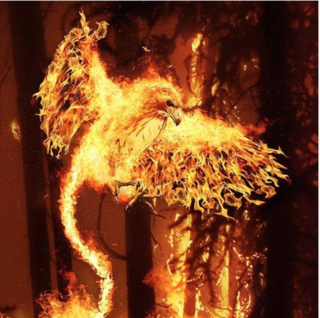Trauma
Searching for Hope on the Dark Side
Destruction, rebirth and other lessons from the abyss.
Posted May 28, 2020

Lately, I’ve been plumbing the depths of the underworld for clues about how to navigate a global pandemic and national cataclysm. No, I’m not holding seances or sticking pins in effigies of megalomaniacs, tempting as that may be. But rather, I’m turning to stories and symbols of human encounters with the forces of destruction in an effort to find hope, guidance, and meaning.
As a Jungian-leaning psychotherapist, my explorations have inevitably led me to the “Destroyer archetype.” Generally speaking, an archetype is a metaphorical image or narrative, as found in myths, culture, and history that conveys a recognizable set of experiences that transcend time and place.
Archetypal storylines usually involve some sort of journey, literally and figuratively, whereby the hero confronts a series of obstacles that push them to grow into stronger, more evolved characters. Such narratives include the search for love, truth, self, justice, and redemption—for example, the hero’s journey in the Odyssey, The Wizard of Oz, or the original Star Wars films. They can also describe particular character types, like the warrior, the magician, the seeker, the lover, the queen, the sage, or symbols found in famous paintings, decks of cards, street signs, and even emojis. With both character types and symbols, the story is implied.
Swiss psychiatrist and psychoanalyst Carl Jung proposed that our lives play out variations on these archetypal plotlines, forcing us to confront a particular set of challenges that stretch us beyond our comfort zones into higher levels of consciousness. For example, the sacrifices required for a caregiving archetypal experience, whether parenting or tending to an infirm elder, can help us grow into more loving, altruistic, and emotionally attuned individuals.
The Destroyer Archetype
Although tests of love, strength, courage, endurance are part of the package, all archetypes, even the more difficult ones, have lessons and gifts that can ultimately enhance our lives if we rise to the challenge. Hence the impetus for my underworld explorations in the domain of the so-called "Destroyer archetype."
As described by Jungian scholars Carol Pearson and Hugh Marr, Destroyer archetypes may be seen in traumatic experiences of varying degrees that shatter the status quo, destabilize our lives, and bring us to our knees. Whether it’s the sudden loss of a loved one, a natural disaster, a life-threatening illness, or a global pandemic, Destroyer experiences force us to surrender to forces beyond our control, whether we like it or not.
And yet there is a rebirth at the end of the dark passage, usually in the form of redemption or a more authentic life.
There are countless examples of Destroyer archetypal storylines and images. Perhaps the best known is the mythical Phoenix that rises from the ashes after igniting its nest with a single clap of its wings.
Similarly, the Tower card in the Tarot deck card shows a tower on a mountain top that has been struck by a bolt of lightning, setting it ablaze. A man and woman are depicted falling from off the tower, their bodies pitched upside down. While this may evoke disturbing memories of September 11, the card is supposedly based on the biblical Tower of Babel, destroyed by God to humble humans who tried to breach the heavens by their own devices.
Some experiences turn our lives upside down with sudden, shocking force. The moral of the Tower of Babel story is that if you build your world on ego-driven pursuits and false foundations, fancying yourself as all-powerful, you’re doomed to fall. It also reminds us that everything we counted on to define ourselves may not be here tomorrow, so we must adapt and become flexible.
Destroyer images are also present in world religions, from the biblical story of Job to the Hindu god Shiva. Job is a good man who, with God’s permission, loses his offspring, health, and property, but is ultimately restored to an even better condition because, in spite of his anguish, he doesn’t lose faith. Shiva, also known literally as “The Destroyer,” is an androgynous shape-shifter who transforms the universe through destruction and rebirth. Both an ascetic and the master of fertility, Shiva is the master of both poison and medicine, suggesting that pain can wake us up to areas in our lives that need improvement.
Lessons and Gifts from the Dark Side
To that point, we can’t fix what we can’t see. That’s why one of the gifts of the Destroyer archetype is an embodied crucible that pushes us to feel the pain of our shadow so we can get to know and ultimately heal it. Thus, the fires consume the structures that are no longer essential—ambitions, identities, addictions—clearing a space for an intensity of reflection that can help us rebuild on a stronger foundation that is more aligned with our deeper truths and needs. Even when they consume significant and meaningful people or things, we can grow in compassion as we attune our hearts to universal suffering and our common humanity.
In What Story Are You Living?, Pearson and Marr note that one of the Destroyer’s gifts are humility and expansiveness. “When people move beyond the fear of death, loss or change, they gain an incredible kind of freedom that can take the form of the ability to live fully in the moment, the capacity to take risks without undue stress, and the willingness to risk failure in order to create deeper knowledge, and the wisdom to flow with life’s changes. When we make friends with the Destroyer, we no longer need to shrink in fear, holding on to what we have. We begin to see that’s it’s possible to trust the unknown.”
The archetypal Destroyer is reflected in nature as well in the continuous cycle of birth, life and death. For example, wildfires, when allowed to burn in areas where they do not impact human development, are regenerative for the forest, revitalizing the watershed, renewing the soil, and resetting the clock for the ecosystem.
Navigation Tips
Even with hope, falling is no fun, especially when you’re getting singed on the way down. Thankfully, there are ways we can seek to facilitate a softer landing.
- Take inventory: Examine your values, priorities, strengths, resources, and areas needing improvement. Try to distinguish wants from needs. When possible, let go of situations, relationships, and things that no longer serve you. Reflect on lessons learned from previous difficult experiences that can be applied to the current moment.
- Embrace rituals and nature: Use existing rituals or create new ones to mark losses, embody uncertainty, or express the journey through the past, present, and future. Take walks outdoors to remember and internalize nature’s honesty, resilience, and enduring beauty.
- Connect with others: Share stories, humor, music, appreciation, and quality time with friends, family, and colleagues. Be kind and reach out for support, and help others when possible to reinforce your common humanity
- Be creative: Destruction presents an opportunity for creation through self-expression. Some of the greatest works of art—for example, Picasso’s Guernica—were inspired by traumatic experiences.
Finally, while grieving our pre-pandemic lives, it’s worth noting that the Destroyer archetype suggests an opportunity for alchemy, a chance to emerge from the purifying fires with greater luminosity. Presuming I make it, I can’t help but wonder at the me I’ll be at the end of this perilous chapter. I can only hope that like the mythical Phoenix, I emerge from the ashes, with my heart open and my wings spread wide, to a more compassionate world.
References
Pearson, C. & Marr, H. (2007). What Story Are You Living. Gainesville, FL: Center for Applications of Psychological Type, Inc.




